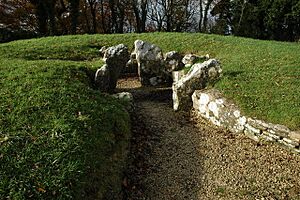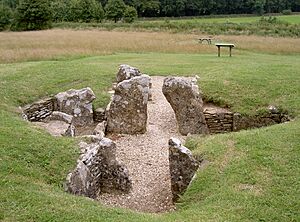Nympsfield Long Barrow facts for kids
The Nympsfield Long Barrow is an ancient burial site from the Neolithic period, also known as the New Stone Age. It's located near the village of Nympsfield in Gloucestershire, South West England.
This special place is found at the edge of a forest and is now a picnic spot. It's one of the very first burial mounds (called barrows) that had separate rooms inside. People built it around 2800 BCE, which is about 4,800 years ago!
Nympsfield Long Barrow is a protected historical site. It is looked after by English Heritage, an organization that cares for important places in England. Many items found during digs here are now kept at the Gloucester City Museum.
Where is Nympsfield Long Barrow?
Nympsfield Long Barrow is southeast of the B4066 road. It's about 6 miles (10 km) southwest of Stroud and 14 miles (23 km) west of Cirencester. You can find it inside Coaley Peak Country Park.
The original burial mound can no longer be seen today. Like other barrows in this area, it sits on the edge of a steep slope. This slope is made of a type of rock called limestone, which often contains small, egg-shaped stones.
What did the Barrow look like?
The Nympsfield Long Barrow was shaped like a trapezoid, wider at one end. It measured about 27 meters long and 18 meters wide. At the eastern end, there were curved walls that led into a square open area, like a courtyard.
From this courtyard, you could enter a central passage. Three rooms branched off this passage. There were two larger rooms on each side and a smaller one at the very end. Stones were placed to make the openings to these rooms narrower. A small part of the north room was even separated to create a tiny stone box, called a cist. The barrow was built so its longest side pointed from the southeast to the northwest.
What was found during the digs?
Archaeologists have dug at Nympsfield Long Barrow three times. The first dig was in 1862, then in 1937, and finally in 1974. During these excavations, the remains of 23 people were found inside the barrow.
The ashes of children were placed in a separate stone box. Scientists noticed that most of the people had common health problems, like infections in their mouths and gums. It's thought that after bodies were placed inside, they were left for a certain time. Then, a special event happened, and the tomb was sealed forever.
Archaeologists also found a red mineral called Hematite in the mound. People might have used it as face-paint to make the dead look more alive.
The digs also uncovered signs of fires and pig bones in the courtyard area. This suggests that people had special meals there during burial ceremonies. Some dog bones were also found. However, it's not clear if these dogs lived at the time the barrow was built or much later.
Nympsfield was once thought to be the only chambered barrow where bird bones were found. But now, other sites like the Tomb of the Eagles in the Orkney Islands have also shown this.
Other discoveries included a leaf-shaped arrow-head and pieces of pottery. Two pottery containers, a bowl and a jar, were put back together. They are from a type of pottery called Ebbsfleet ware. Shiny Quartz pebbles were also found blocking the entrances of the mound. These pebbles are common in many long barrows in this area. People believe they had a special symbolic meaning.
Nympsfield Long Barrow is part of a group of similar ancient monuments called the Cotswold–Severn group. Its design is much like the tombs found at Uley and Notgrove. It's also close to another ancient burial site known as the "Soldier's Grave." This area was also used by people during the Iron Age and Roman times, long after the barrow was built.



